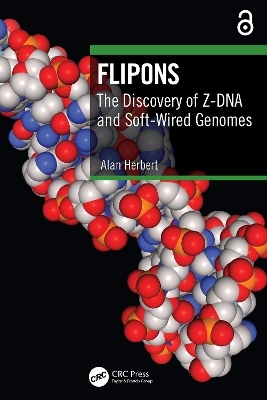
Flipons
CRC Press (Verlag)
978-1-032-73108-7 (ISBN)
Key Features
Causes us to rethink how information is encoded in the genome
Changes our understanding of how our genome evolved and how we protect ourselves against viruses and cancers while sparing normal cells
Shows that high energy forms of DNA, such as left-handed DNA do exist inside the cell
Accessible to those in academia and the general public, and speaks to the next generation, encouraging them to find their own path in scientific discovery
The Open Access version of this book, available at http://www.taylorfrancis.com, has been made available under a Creative Commons Attribution-Non-Commercial-No Derivative License (CC-BY-NC-ND) 4.0 license.
Dr. Alan Herbert's career spans both academia and industry. He is Head of Discovery at InsideOutBio and has published in high profile journals. His work on left-handed Z-DNA and Z-RNA has proven that besides the right-handed DNA double helix that Watson and Crick first described, higher energy forms of DNA and RNA are used in the cell to regulate many important biological functions including defenses against viruses and cancer and to regulate the readout of information from the genome. His publications include one providing the first genetic evidence for the biological relevance of the Z-DNA/Z-RNA conformation. This work started with his discovery at MIT of the Zα family of proteins that recognize a form of left-handed DNA called Z-DNA. During this time, Dr. Herbert has had many fruitful collaborations with scientists worldwide who have made great contributions to the work. These discoveries led to the therapeutic targeting of ZBP1lated to develop a new therapy for the treatment of solid tumors. In other endeavors, he pioneered the use of Genome Wide Association Studies at Boston University and contributed to the development of new drug programs at Merck. Dr. Herbert has also helped expand understanding of the role of the alternative DNA structures encoded by genetic elements called flipons in evolution. He has also detailed mechanisms by which the interactions between small noncoding RNAs and flipons regulate the sequence-specific read of genes during embryonic development.
Preface
Part I
Chapter 1 The Dawn
Chapter 2 Even smart people are sometimes wrong
Chapter 3: Coming to America
Chapter 4 From One Unknown to Another
Chapter 5: Failing successfully everywhere else. The in-between years.
Chapter 6: How do you know it’s you? The answer lies in your Z-RNA
Chapter 7: Can left-handed Z-DNA and Z-RNA kill you?
Chapter 8: Does Z-DNA regulate transcription?
Chapter 9: Luck and the Business of Science
Part II
Chapter 10: What about other types of flipons?
Chapter 11: Is your genome soft-wired?
Chapter 12: How do you assemble a soft-wired genome?
Chapter 13: How do you program a soft-wired genome?
Chapter 14. Is life intransitive?
Chapter 15: Are RNA therapeutics the wave of the future?
Epilogue: Why have a career in science?
| Erscheinungsdatum | 29.03.2024 |
|---|---|
| Zusatzinfo | 23 Line drawings, color; 16 Line drawings, black and white; 26 Halftones, color; 12 Halftones, black and white; 49 Illustrations, color; 28 Illustrations, black and white |
| Verlagsort | London |
| Sprache | englisch |
| Maße | 148 x 210 mm |
| Gewicht | 385 g |
| Themenwelt | Naturwissenschaften ► Biologie ► Biochemie |
| Naturwissenschaften ► Biologie ► Genetik / Molekularbiologie | |
| ISBN-10 | 1-032-73108-7 / 1032731087 |
| ISBN-13 | 978-1-032-73108-7 / 9781032731087 |
| Zustand | Neuware |
| Haben Sie eine Frage zum Produkt? |
aus dem Bereich


